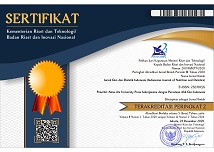The status of dietary diversity score among school-aged children between rural and urban areas
Abstract
ABSTRAK
Latar Belakang: Bagi anak sekolah dasar (SD) status gizi yang cukup akan menunjang kemampuan akademiknya di sekolah. Akan tetapi, disaat pembatasan social berskala besar (PSBB) berlaku pengukuran status gizi tidak mungkin dilakukan karena dapat meningkatkan resiko penularan.
Tujuan: mengetahui status gizi anak sekolah dasar (SD) menggunakan skor keberagaman makanan.
Metode: Metode cross sectional digunakan pada penelitian ini dengan mengikutsertakan 58 pasang ibu dan siswa SD di wilayah Banyumas. Pengambilan data keberagaman makanan dilakukan menggunakan kuesioner online melalui google form. Uji analisis yang digunakan adalah uji chi square.
Hasil: Rata-rata siswa SD di Kabupaten Banyumas mengonsumsi 6 kelompok makanan dalam sehari dimana kelompok makanan yang sangat jarang dikonsumsi adalah kelompok daging yaitu sebesar 17.2%. Tiga kelompok makanan yang paling sering dikonsumsi adalah kelompok susu (74.1%), telur (67.2%) dan kacang-kacangan (62.1%). Berdasarkan hasil analisis bivariat, tidak ada perbedaan yang signifikan antara keberagaman makanan siswa SD di wilayah perkotaan dan perdesaan. Namun ada kecenderungan siswa yang tinggal di wilayah perkotaan memiliki skor keberagaman yang lebih tinggi.
Kesimpulan: Tidak ada perbedaan antara keberagaman makanan antara wilayah perkotaan dan perdesaan di Kabupaten Banyumas. Namun ada kecenderungan bahwa siswa di wilayah SD lebih beragam.
KATA KUNCI: COVID 19; keberagaman makanan; perdesaan dan perkotaan; siswa SD
ABSTRACT
Background: School-aged children should maintain a better nutritional status to ensure the quality of their academic performance. However, during pandemic COVID 19 the weight and height measurement could increase the risk of spreading the virus.
Objectives: To determine the the indicators of school-aged children’s nutritional status using dietary diversity score (DDS).
Methods: In total 58 pairs of mothers and children were included in a cross-sectional study. The data of dietary diversity was collected using an online questionnaire through a google form. The chi-square analysis was used to assess the significant differences.
Results: On average, school-aged children consumed six food groups a day. The three most consumed food groups were oil and fats, sweet and dark leafy vegetables, namely 51, 56, and 53 students respectively. There was a significant difference in the consumption of fresh meat and other fruits between urban and rural areas. Based on bivariate analysis, there was no significant difference in DDS within students’ characteristics. However, there was a better DDS trend within fathers’ occupation, mothers working status, and mothers’ knowledge level.
Conclusions: There was a tendency that plant-based food was mostly consumed in rural areas and animal-based food was mostly consumed in urban areas. Furthermore, the study confirmed parental factors on students' food consumption.
KEYWORDS: COVID 19; dietary diversity score; urban dan rural; school-aged children
Keywords
Full Text:
PDFReferences
John W. Erdman Jr, Macdonald IA, Zeisel SH. Present Knowledge in Nutrition. 10th ed. Iowa: Wiley-Blackwell; 2012. 637–650 p.
Haapala EA, Eloranta AM, Venäläinen T, Jalkanen H, Poikkeus AM, Ahonen T, et al. Diet quality and academic achievement: a prospective study among primary school children. Eur J Nutr. 2017;56(7):2299–308.
Florence Opoola, Samuel Sunday Adebisi AOI. The study of nutritional status and academic performance of primary school The study of nutritional status and academic performance of primary school children in Zaria , Kaduna State , Nigeria. Ann Bioanthropology. 2016;4(January 2016).
Meng L, Wang Y, Li T, van Loo-Bouwman CA, Zhang Y, Szeto IMY. Dietary diversity and food variety in Chinese children aged 3–17 years: Are they negatively associated with dietary micronutrient inadequacy? Nutrients. 2018;10(11):1–13.
Badan Penelitian dan Pengembangan Kesehatan Kementerian Kesehatan RI. Buku Studi Diet Total : Survei Konsumsi Makanan Individu (Total Diet Survey: Survey of Personal Food Consumption). 1st ed. Jakarta: Lembaga Penerbitan Badan Penelitian dan Pengembangan Kesehatan Kementerian Kesehatan RI; 2014.
Oninla SO, Owa JA, Onayade AA, Taiwo O. Comparative Study of Nutritional Status of Urban and Rural Nigerian School Children. 2006;(October):39–43.
Nabag FO. Comparative Study of Nutritional Status of Urban and Rural School Girl’s Children Khartoum State, Sudan. 2011;12(December):60–8.
Kosaka S, Suda K, Gunawan B, Raksanagara A, Watanabe C, Umezaki M. Urban-rural difference in the determinants of dietary and energy intake patterns: A case study in West Java, Indonesia. PLoS One. 2018;13(5):1–18.
Food and Agriculture Organization. Guidelines for measuring household and individual dietary diversity [Internet]. Fao. 2010. 1–60 p. Available from: http://www.fao.org/fileadmin/user_upload/wa_workshop/docs/FAO-guidelines-dietary-diversity2011.pdf.
Steyn N, Nel J, Nantel G, Kennedy G, Labadarios D. Food variety and dietary diversity scores in children: are they good indicators of dietary adequacy? Public Health Nutr. 2006;9(5):644–50.
Nisak, A.J., Mahmudiono T. Pola Konsumsi Makanan Jajanan di Sekolah Dapat Meningkatkan Rrsiko Overweight/Obesitas pada Anak (Studi di SD Negeri Ploso I-172 Kecamatan Tambaksari Surabaya Tahun 2017). J Berk Epidemiol [Internet]. 2017;5(3):298–382. Available from: https://www.researchgate.net/publication/322591609.
Codjoe SNA, Okutu D, Abu M. Urban Household Characteristics and Dietary Diversity. Food Nutr Bull. 2016;37(2):202–18.
Bao KY, Ph D, Tong D, Ph D, Plane DA, Ph D, et al. Urban food accessibility and diversity : Exploring the role of small non-chain grocers. Appl Geogr [Internet]. 2020;125(October 2019):102275. Available from: https://doi.org/10.1016/j.apgeog.2020.102275.
Huang Y, Tian X. Food accessibility , diversity of agricultural production and dietary pattern in. Food Policy [Internet]. 2019;84(September 2018):92–102. Available from: https://doi.org/10.1016/j.foodpol.2019.03.002.
Scaglioni S, Cosmi V De, Ciappolino V, Brambilla P, Agostoni C. Factors Influencing Children ’ s Eating Behaviours. 2018;1–17.
Mitchell GL, Farrow C, Haycraft E, Meyer C. Parental influences on children’s eating behaviour and characteristics of successful parent-focussed interventions. Appetite. 2013;60:85–94.
Nazzaro C, Lerro M, Marotta G. Assessing parental traits affecting children’s food habits: an analysis of the determinants of responsible consumption. Agric Food Econ. 2018;6(1).
DOI: http://dx.doi.org/10.21927/ijnd.2021.9(1).11-18
Refbacks

This work is licensed under a Creative Commons Attribution-ShareAlike 4.0 International License.
Indonesian Journal of Nutrition and Dietetics (IJND) indexed by:
 View My Stats
View My Stats



12.png)


























